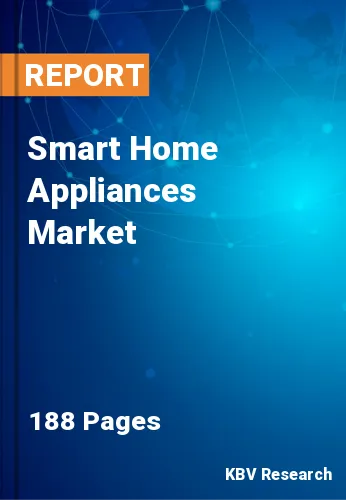The Global Smart Home Appliances Market size is expected to reach $49.9 billion by 2028, rising at a market growth of 8.7% CAGR during the forecast period.
Smart home appliances are Wi-Fi-enabled device that connects to a voice command system or a smart hub, such as Google Assistant, Amazon Alexa, or a smart home app. The gadgets in a smart home are interconnected and accessible from a single hub, like a tablet, smartphone, laptop, or gaming console. One home automation system may operate several functions including door locks, televisions, thermostats, cameras, home monitors, lights, and even appliances like the refrigerator.
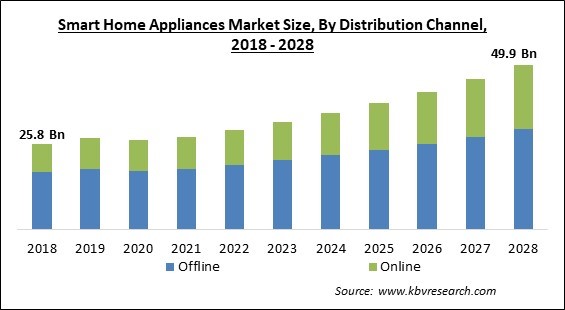
The user can set time schedules for specific changes to take effect using the system, which is installed on a mobile device or other networked devices. Smart home appliances have self-learning capabilities that allow them to figure out the homeowner's schedules and adjust as necessary. Lighting control in smart homes enables residents to save money on energy costs while using less electricity.
When the owner is away from the house, some home automation systems sound an alarm, while other devices can notify the police or the fire department in the event of an emergency. Once connected, IoT technology, a network of physical items that can collect and share electronic information, includes services like a smart security system, smart doorbell, and smart appliances.
When an appliance is connected to a central system and has the capability to be programmed, controlled remotely, or function on its own, depending on information from sensors detecting elements, like light levels, temperature, or activity, the appliance is said to be a smart appliance. Ideally, as part of a larger smart home, smart appliances are made to work together with other smart devices.
They provide consumers with advantages including better energy management as well as more comfort, convenience, and security. The production of items that consumers desire to buy and use as well as new revenue streams on the basis of factors, like automated consumables replacement or efficiencies in development, manufacturing, installation, and maintenance are all ways that smart appliances can boost manufacturers' profits.
As smart home appliances are costly, various people were not able to purchase them. In addition, the worldwide supply chain was also disrupted, which posed a challenge of a lack of raw materials required for the production of smart home appliances. Hence, the growth of the smart home appliances market was majorly hampered. However, given the increased popularity of online/e-commerce sales, the industry is estimated to recover during the forecast period. A lot of consumers have started making improvements to or full remodels of their homes. During the pandemic, several businesses have witnessed an improvement in remodeling efforts. Brands are paying close attention to their target demographic as the market grows and have been modifying their marketing tactics to draw in customers.
Consumers in the home are extremely concerned about the rising expense of electricity bills. An extensive quantity of electricity is used by equipment like air conditioners, refrigerators, water heaters, lighting fixtures, as well as home entertainment systems. The homes are turning to energy-saving measures as a result of these higher expenditures. Smart home appliances that can communicate with each other have become an excellent option in such a situation. As a result, households are implementing smart home gadgets to reduce energy expenditures. Wireless communication technology developments would enable remote control of residential equipment.
Wireless solutions offer flexibility to end users by lowering the requirement for cables while also eliminating the need to rebuild prevailing residences. To enhance the functionality of smart appliances, numerous new wireless protocols have been created. Apart from existing technologies, like Bluetooth and Wi-Fi, the introduction of ZigBee as well as Z-Wave is estimated to result in significant technological breakthroughs across the smart appliances market.
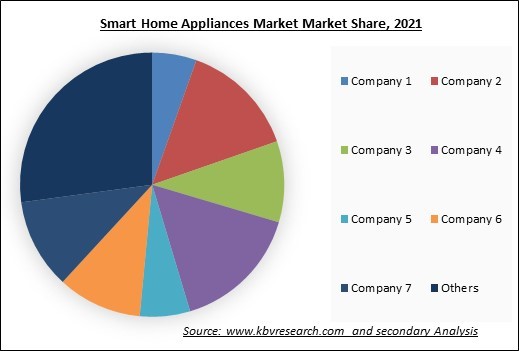
The leading players in the market are competing with diverse innovative offerings to remain competitive in the market. The below illustration shows the percentage of revenue shared by some of the leading companies in the market. The leading players of the market are adopting various strategies in order to cater demand coming from the different industries. The key developmental strategies in the market are Product Launches.
When compared to traditional appliances, smart appliances are more expensive. All of the home's equipment must be connected together via a single communication interface. Depending on the number of appliances and technology used, installation charges can vary significantly and become unaffordable for a customer. Even if it would be beneficial in the long run, it can be challenging for businesses to gain the traction of customers at these prices.
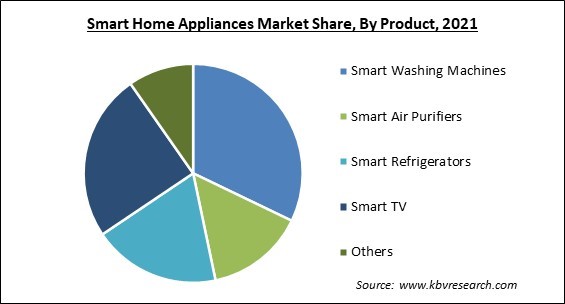
On the basis of Product, the Smart Home Appliances Market is segregated into Smart Washing Machines, Smart Refrigerators, Smart Air Purifiers, Smart TV, and Others. In 2021, the smart air purifiers segment recorded a significant revenue share of the smart home appliances market. Since people are becoming more concerned about their health as well as the environment they live in, smart air purifiers are becoming a crucial component of smart homes. Due to their additional features that give customers a high degree of flexibility and convenience, smart air purifiers are also becoming more and more popular than traditional air purifiers.
By Distribution Channel, the Smart Home Appliances Market is bifurcated into Online and Offline. In 2021, the offline segment procured the biggest revenue share of the smart home appliances market. The convenience of physically inspecting the product, the availability of an in-store employee or expert, and help with product specifications are a few of the factors promoting the sales of smart home appliances via offline retail channels.
| Report Attribute | Details |
|---|---|
| Market size value in 2021 | USD 28.1 Billion |
| Market size forecast in 2028 | USD 49.9 Billion |
| Base Year | 2021 |
| Historical Period | 2018 to 2020 |
| Forecast Period | 2022 to 2028 |
| Revenue Growth Rate | CAGR of 8.7% from 2022 to 2028 |
| Number of Pages | 188 |
| Number of Tables | 273 |
| Report coverage | Market Trends, Revenue Estimation and Forecast, Market Share Analysis, Segmentation Analysis, Regional and Country Breakdown, Competitive Landscape, Companies Strategic Developments, Company Profiling |
| Segments covered | Product, Distribution Channel, Region |
| Country scope | US, Canada, Mexico, Germany, UK, France, Russia, Spain, Italy, China, Japan, India, South Korea, Singapore, Malaysia, Brazil, Argentina, UAE, Saudi Arabia, South Africa, Nigeria |
| Growth Drivers |
|
| Restraints |
|
Region-Wise, the Smart Home Appliances Market is analyzed across North America, Europe, Asia-Pacific, and LAMEA. In 2021, North America witnessed the largest revenue share of the smart home appliances market. The market is being driven by an increase in the renovation and building of outdated commercial and residential infrastructure in developed nations, like the United States and Canada.
Free Valuable Insights: Global Smart Home Appliances Market to reach USD 49.9 Billion by 2028
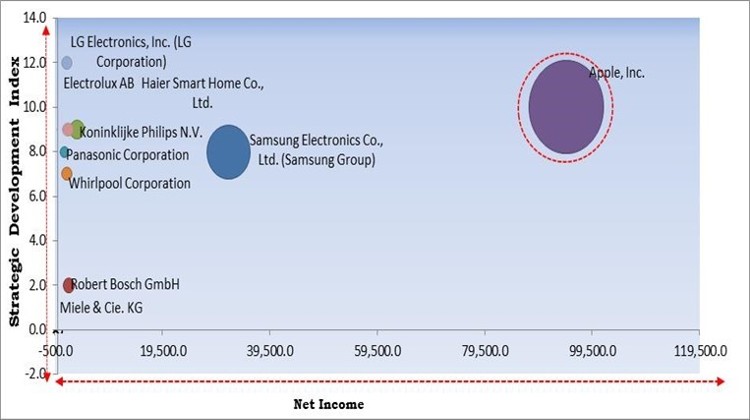
The major strategies followed by the market participants are Product Launches. Based on the Analysis presented in the Cardinal matrix; Apple, Inc. is the forerunners in the Smart Home Appliances Market. Companies such as Samsung Electronics Co., Ltd. (Samsung Group), Koninklijke Philips N.V., LG Electronics, Inc. (LG Corporation) are some of the key innovators in Smart Home Appliances Market.
The market research report covers the analysis of key stake holders of the market. Key companies profiled in the report include Apple, Inc., Panasonic Corporation, Samsung Electronics Co., Ltd. (Samsung Group), Robert Bosch GmbH, LG Electronics, Inc. (LG Corporation), Whirlpool Corporation, Electrolux AB, Haier Smart Home Co., Ltd., Koninklijke Philips N.V., and Miele & Cie. KG.
By Distribution Channel
By Product
By Geography
The Smart Home Appliances Market size is projected to reach USD 49.9 billion by 2028.
Rising Electricity Costs And Increasing Technological Advancements are driving the market in coming years, however, High Installation And Maintenance Cost restraints the growth of the market.
Apple, Inc., Panasonic Corporation, Samsung Electronics Co., Ltd. (Samsung Group), Robert Bosch GmbH, LG Electronics, Inc. (LG Corporation), Whirlpool Corporation, Electrolux AB, Haier Smart Home Co., Ltd., Koninklijke Philips N.V., and Miele & Cie. KG.
The expected CAGR of the Smart Home Appliances Market is 8.7% from 2022 to 2028.
The Smart Washing Machines segment acquired maximum revenue share in the Global Smart Home Appliances Market by Product in 2021 thereby, achieving a market value of $14.6 billion by 2028.
The North America market dominated the Global Smart Home Appliances Market by Region in 2021, and would continue to be a dominant market till 2028; thereby, achieving a market value of $17.1 Billion by 2028.
Our team of dedicated experts can provide you with attractive expansion opportunities for your business.
